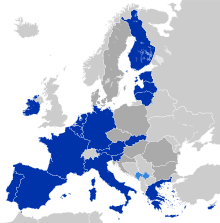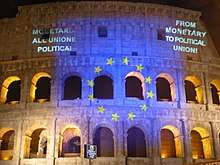Treaty of Rome
The Treaty of Rome, officially the Treaty establishing the European Economic Community (or EEC Treaty in short) brought about the creation of the European Economic Community (EEC), the best-known of the European Communities (EC). It was signed on 25 March 1957 by Belgium, France, Italy, Luxembourg, the Netherlands and West Germany and came into force on 1 January 1958. Under the name Treaty on the Functioning of the European Union, it remains one of the two most important treaties in the modern-day European Union (EU).
 The signing ceremony of the Treaty at the Palazzo dei Conservatori on the Capitoline Hill | |
| Type | Founding treaty |
|---|---|
| Signed | 25 March 1957 |
| Location | Capitoline Hill in Rome, Italy |
| Effective | 1 January 1958 |
| Parties | EU member states |
| Depositary | Government of Italy |
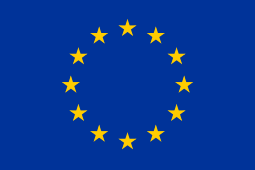 |
|---|
| This article is part of a series on the politics and government of the European Union |
|
Member States (27) Candidate countries for EU Accession
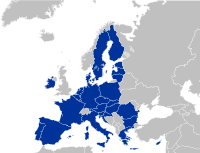 European Union since 31 January 2020 |
Treaties of Accession
Treaties of Succession
Other Treaties
Abandoned treaties and agreements
|
|
Executive
|
|
Legislature
European Parliament
(Members)
National parliaments |
|
Judiciary Court of Justice of the EU
|
|
Schengen Area Member States
Schengen Area since 2015 |
|
EEA Members
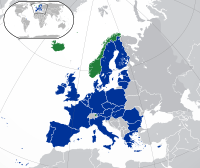 European Economic Area |
|
|
Other Bodies |
Elections in EU Member States
|
|
|
Policies and Issues
|
|
Other Other currencies in use
Non-Schengen Area States
|
|
Foreign Relations High Representative
Foreign relations of EU Member States
|
|
The TEEC proposed the progressive reduction of customs duties and the establishment of a customs union. It proposed to create a single market for goods, labour, services, and capital across the EEC's member states. It also proposed the creation of a Common Agriculture Policy, a Common Transport Policy and a European Social Fund, and established the European Commission.
The treaty has been amended on several occasions since 1957. The Maastricht Treaty of 1992 removed the word "economic" from the Treaty of Rome's official title and, in 2009, the Treaty of Lisbon renamed it the "Treaty on the Functioning of the European Union".
History
Background
In 1951, the Treaty of Paris was signed, creating the European Coal and Steel Community (ECSC). The Treaty of Paris was an international treaty based on international law, designed to help reconstruct the economies of the European continent, prevent war in Europe and ensure a lasting peace.
The original idea was conceived by Jean Monnet, a senior French civil servant and it was announced by Robert Schuman, the French Foreign Minister, in a declaration on 9 May 1950. The aim was to pool Franco-West German coal and steel production, because the two raw materials were the basis of the industry (including war industry) and power of the two countries. The proposed plan was that Franco-West German coal and steel production would be placed under a common High Authority within the framework of an organisation that would be open for participation to other European countries. The underlying political objective of the European Coal and Steel Community was to strengthen Franco-German cooperation and banish the possibility of war.
France, West Germany, Italy, Belgium, Luxembourg, and the Netherlands began negotiating the treaty. The Treaty Establishing the ECSC was signed in Paris on 18 April 1951, and entered into force on 24 July 1952. The Treaty expired on 23 July 2002, after fifty years, as was foreseen. The common market opened on 10 February 1953 for coal, iron ore and scrap, and on 1 May 1953 for steel.
Partly in the aim of creating a United States of Europe, two further Communities were proposed, again by the French. A European Defence Community (EDC) and a European Political Community (EPC). While the treaty for the latter was being drawn up by the Common Assembly, the ECSC parliamentary chamber, the EDC was rejected by the French Parliament. President Jean Monnet, a leading figure behind the Communities, resigned from the High Authority in protest and began work on alternative Communities, based on economic integration rather than political integration.[1]
As a result of the energy crises, the Common Assembly proposed extending the powers of the ECSC to cover other sources of energy. However, Monnet desired a separate Community to cover nuclear power, and Louis Armand was put in charge of a study into the prospects of nuclear energy use in Europe. The report concluded that further nuclear development was needed, in order to fill the deficit left by the exhaustion of coal deposits and to reduce dependence on oil producers. The Benelux states and West Germany were also keen on creating a general common market; however, this was opposed by France owing to its protectionist policy, and Monnet thought it too large and difficult a task. In the end, Monnet proposed creating both as separate Communities to attempt to satisfy all interests.[2] As a result of the Messina Conference of 1955, Paul-Henri Spaak was appointed as chairman of a preparatory committee, the Spaak Committee, charged with the preparation of a report on the creation of a common European market.
Move towards a single market
The Spaak Report[3] drawn up by the Spaak Committee provided the basis for further progress and was accepted at the Venice Conference (29 and 30 May 1956) where the decision was taken to organise an Intergovernmental Conference. The report formed the cornerstone of the Intergovernmental Conference on the Common Market and Euratom at Val Duchesse in 1956.
The outcome of the conference was that the new Communities would share the Common Assembly (now the Parliamentary Assembly) with the ECSC, as they would the European Court of Justice. However, they would not share the ECSC's Council of High Authority. The two new High Authorities would be called Commissions, from a reduction in their powers. France was reluctant to agree to more supranational powers; hence, the new Commissions would have only basic powers, and important decisions would have to be approved by the Council (of national Ministers), which now adopted majority voting.[4] Euratom fostered co-operation in the nuclear field, at the time a very popular area, and the European Economic Community was to create a full customs union between members.[5][6]
Signing
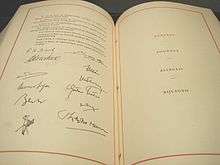
The conference led to the signing on 25 March 1957, of the Treaty establishing the European Economic Community and the Euratom Treaty at the Palazzo dei Conservatori on Capitoline Hill in Rome.
In March 2007, the BBC's Today radio programme reported that delays in printing the treaty meant that the document signed by the European leaders as the Treaty of Rome consisted of blank pages between its frontispiece and page for the signatures.[7][8][9]
| Signatories | For |
|---|---|
| Paul-Henri Spaak · Jean-Charles Snoy et d'Oppuers | |
| Konrad Adenauer · Walter Hallstein | |
| Christian Pineau · Maurice Faure | |
| Antonio Segni · Gaetano Martino | |
| Joseph Bech · Lambert Schaus | |
| Joseph Luns · J. Linthorst Homan |
Anniversary commemorations
Major anniversaries of the signing of the Treaty of Rome have been commemorated in numerous ways.
Commemorative coins

Commemorative coins have been struck by numerous European countries, notably at the 30th and 50th anniversaries (1987 and 2007 respectively).
2007 celebrations in Berlin
In 2007, celebrations culminated in Berlin with the Berlin declaration preparing the Lisbon Treaty.
2017 celebrations in Rome
In 2017, Rome was the centre of multiple official[11][12][13] and popular celebrations.[14][15] Street demonstrations were largely in favour of European unity and integration, according to several news sources.[16][17][18][19]
Historical assessment
According to the historian Tony Judt, the Treaty of Rome did not represent a fundamental turning point in the history of European integration:
It is important not to overstate the importance of the Rome Treaty. It represented for the most part a declaration of future good intentions...Most of the text constituted a framework for instituting procedures designed to establish and enforce future regulations. The only truly significant innovation – the setting up under Article 177 of a European Court of Justice to which national courts would submit cases for final adjudication – would prove immensely important in later decades but passed largely unnoticed at the time.[20]
See also
- History of the European Union
- Intergovernmental Conference on the Common Market and Euratom
- Ohlin Report
- Spaak Report
- European Coal and Steel Community
- Euratom
- European Economic Community
References
- Raymond F. Mikesell, The Lessons of Benelux and the European Coal and Steel Community for the European Economic Community, The American Economic Review, Vol. 48, No. 2, Papers and Proceedings of the Seventieth Annual Meeting of the American Economic Association (May, 1958), pp. 428–441
- 1957–1968 Successes and crises – CVCE (Centre for European Studies)
- The Brussels Report on the General Common Market (abridged, English translation of document commonly called the Spaak Report) – AEI (Archive of European Integration)
- Drafting of the Rome Treaties – CVCE (Centre for European Studies)
- A European Atomic Energy Community – CVCE (Centre for European Studies)
- A European Customs Union – CVCE (Centre for European Studies)
- "What really happened when the Treaty of Rome was signed 50 years ago".
- EU landmark document was 'blank pages'
- "How divided Europe came together". 23 March 2007 – via news.bbc.co.uk.
- MFE (26 March 2017). "The "European" Colosseum created by federalists on the first page of Frankfurter Allgemeigne Sonntagszeitung! #MarchForEurope2017pic.twitter.com/8JW7o4usBb".
- "European Commission – PRESS RELEASES – Press release – Rome Declaration of the Leaders of 27 Member States and of the European Council, the European Parliament and the European Commission". europa.eu. Retrieved 26 March 2017.
- "Speech by President Donald Tusk at the ceremony of the 60th anniversary of the Treaties of Rome – Consilium". www.consilium.europa.eu. Retrieved 26 March 2017.
- "European Commission – PRESS RELEASES – Press release – Speech by President Juncker at the 60th Anniversary of the Treaties of Rome celebration – A new chapter for our Union: shaping the future of EU 27". europa.eu. Retrieved 26 March 2017.
- "Cortei Roma, il raduno dei federalisti. "L'Europa è anche pace, solidarietà e diritti"". Il Fatto Quotidiano (in Italian). 25 March 2017. Retrieved 26 March 2017.
- "Celebrazioni Ue, in 5 mila al corteo europeista". Repubblica.it (in Italian). 25 March 2017. Retrieved 26 March 2017.
- "A Rome, plusieurs milliers de manifestants défilent pour «un réveil de l'Europe»". Libération.fr (in French). Retrieved 26 March 2017.
- "Des milliers de manifestants en marge des 60 ans du traité de Rome". Le Monde.fr (in French). 25 March 2017. ISSN 1950-6244. Retrieved 26 March 2017.
- "Pro-European, Anti-Populist Protesters March as EU Leaders Meet in Rome". Retrieved 26 March 2017.
- "Trattati di Roma, cortei e sit-in: la giornata in diretta" (in Italian). Retrieved 26 March 2017.
- Judt, Tony (2007). Postwar: A History of Europe since 1945. London: Pimlico. p. 303. ISBN 978-0-7126-6564-3.
External links
- Documents of Treaty of Rome's negotiations are at the Historical Archives of the EU in Florence
- History of the Rome Treaties – CVCE (Centre for European Studies)
- Treaty establishing the European Economic Community – CVCE (Centre for European Studies)
- Happy Birthday EU — Union wide design competition to mark the 50th anniversary of the Treaty
- 60th anniversary of the Treaty of Rome – Official Site
